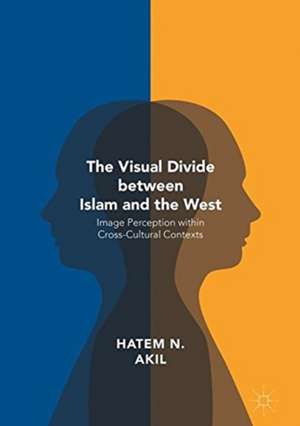The Visual Divide between Islam and the West: Image Perception within Cross-Cultural Contexts
Autor Hatem N. Akilen Limba Engleză Paperback – 30 oct 2019
The book attempts to engage with questions about the ways in which images are perceived within cross cultural contexts. Why and how do people from different cultural backgrounds view the same image in opposing ways; why do cartoon, photographs, and videos become both the cause and target of bloody political violence – as witnessed recently by the deadly attacks against Charlie Hebdo in France and in the swift military response by the US, Jordan, France, and others to videotaped violence by ISIS.
| Toate formatele și edițiile | Preț | Express |
|---|---|---|
| Paperback (1) | 482.94 lei 43-57 zile | |
| Palgrave Macmillan US – 30 oct 2019 | 482.94 lei 43-57 zile | |
| Hardback (1) | 532.05 lei 43-57 zile | |
| Palgrave Macmillan US – 23 dec 2016 | 532.05 lei 43-57 zile |
Preț: 482.94 lei
Nou
Puncte Express: 724
Preț estimativ în valută:
92.42€ • 96.13$ • 76.30£
92.42€ • 96.13$ • 76.30£
Carte tipărită la comandă
Livrare economică 14-28 aprilie
Preluare comenzi: 021 569.72.76
Specificații
ISBN-13: 9781349928422
ISBN-10: 1349928429
Pagini: 232
Ilustrații: XVIII, 232 p. 15 illus., 12 illus. in color.
Dimensiuni: 148 x 210 mm
Greutate: 0.3 kg
Ediția:1st ed. 2016
Editura: Palgrave Macmillan US
Colecția Palgrave Macmillan
Locul publicării:New York, United States
ISBN-10: 1349928429
Pagini: 232
Ilustrații: XVIII, 232 p. 15 illus., 12 illus. in color.
Dimensiuni: 148 x 210 mm
Greutate: 0.3 kg
Ediția:1st ed. 2016
Editura: Palgrave Macmillan US
Colecția Palgrave Macmillan
Locul publicării:New York, United States
Cuprins
.List of Figures.- .Introduction.- .Chapter One: Technologies of Seeing.- .Chapter Two: The Sound of the Revolution.- .Chapter Three: Colonial Gaze--Native Bodies.- .Chapter Four: The Boy Who Was Killed Twice.- .Chapter Five: The Martyr Takes a Selfie.- .Chapter Six: Cinematic Terrorism.- .Endnotes.- .References.
Notă biografică
Hatem N. Akil teaches English at Seminole State College of Florida, USA. His work has been published in Theatre Life Journal and Cinema Life Journal. He was the founder of the Arab American IPTV, Mahjar TV, and Baraka World Music Series. Akil currently serves on the executive committee of the Global Arab/Arab American division of the Modern Language Association.
Textul de pe ultima copertă
This book considers the ways in which Muslims view the way they are being viewed, not viewed, or incorrectly viewed, by the West. The book underscores a certain “will-to-visibility” whereby Muslims/ Arabs wish just to be “seen” and to be marked as fellow human beings. The author relates the failure to achieve this visibility to a state of desperation that inextricably and symmetrically ties visibility to violence. When Syrian and Palestinian refugees recently started refusing to be photographed, they clearly ushered the eventual but inevitable collapse of the image and its final futility. The photograph has been completely emptied of its last remaining possibility of signification.
The book attempts to engage with questions about the ways in which images are perceived within cross cultural contexts. Why and how do people from different cultural backgrounds view the same image in opposing ways; why do cartoon, photographs, and videos become both the cause and target of bloody political violence – as witnessed recently by the deadly attacks against Charlie Hebdo in France and in the swift military response by the US, Jordan, France, and others to videotaped violence by ISIS.
The book attempts to engage with questions about the ways in which images are perceived within cross cultural contexts. Why and how do people from different cultural backgrounds view the same image in opposing ways; why do cartoon, photographs, and videos become both the cause and target of bloody political violence – as witnessed recently by the deadly attacks against Charlie Hebdo in France and in the swift military response by the US, Jordan, France, and others to videotaped violence by ISIS.
Caracteristici
Analyzes the portrayal of Muslims and Arabs in an attempt to understand violent reactions to the representation of these groups in Western media Examines why the depiction of Muslims will be perceived differently by various cultural groups Relates an analysis of the depiction of Muslims and Arabs in Western media to the relationship between Islam and the West












